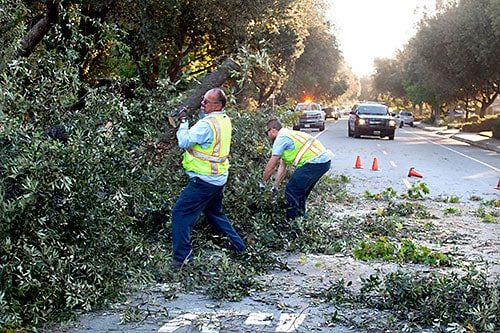City finalizes plan for Claremont’s urban forest

by Matthew Bramlett | news@claremont-courier.com
Claremont officially has a full-fledged plan on how to take care of its trees.
The city council unanimously passed the Urban Forest Management Plan last Tuesday, which outlines visions, goals and objectives for taking care of the city’s trees. The plan was two years in the making, according to Community Services Manager Cari Dillman.
The plan is a flexible document, meaning it can be expanded on and changed, and it will be good for 40 years, Ms. Dillman said. The plan was funded by a $100,000 grant from CalFire in 2017.
The three main goals of the plan are to increase the city’s urban tree canopy and maximize the benefits of the trees, maximize the efficiencies in maintaining the benefits of trees and minimize the risk of trees in the urban environment.
In terms of canopy, the city is waiting on CalFire to release its 2018 land cover data, a crucial part of measuring the canopy. When asked by Mayor Larry Schroeder why the data hasn’t been released, Ms. Dillman responded that to her knowledge, CalFire hasn’t “figured out a platform to release it to all the cities.”
Claremont has over 26,000 trees, with a total valuation of around $88 million, Ms. Dillman said.
Regarding the state of the urban forest, Ms. Dillman said “we’re doing pretty good,” but due to the costs of using private contractors for general upkeep, everything is on a reactionary basis.
“Part of that is because we don’t have a dedicated staff to the urban forest,” Ms. Dillman said. “We do have an arborist on staff, and we have administrative assistants and field staff, but none of that is dedicated at this moment to the urban forest.”
But there are challenges. The polyphagous shot-hole borer and other pests such as the glassy-winged sharpshooter still present a problem to Claremont trees, and climate change and water issues represent long-term threats to the city’s urban forest.
The plan outlines the need to plant climate-appropriate trees to combat those issues, Ms. Dillman said.
No additional funding is being requested as part of the plan, and there was an acknowledgement at the council meeting that many elements of the plan lacked the funding needed to be implemented.
“My concern is we’re going to hear this as we more forward throughout this year—more and more frequently—which is here’s a great plan, here’s a great opportunity, but we don’t have dollars for it,” Councilmember Ed Reece said. “And that’s an unfortunate thing.”
During public comment, Russ Binder suggested a sponsorship program for the city’s trees—a resident can sponsor a tree and raise money for the tree’s upkeep.
“Blow off the grants if you can’t get any more, and have the people who are the direct beneficiaries of such nice trees fund it,” Mr. Binder said.
Mr. Schroeder was receptive, if a little skeptical, of the idea. “My first reaction was sometimes we can’t even get the people who are supposed to water the trees in the parkway to water the trees,” he said.
Still, he told Mr. Binder his idea would be considered.
The council lauded the plan and thanked the Community Services Department for their work in creating it.
Councilmember Jed Leano, in particular, pointed out former Deputy Director of Community Services Dave Roger, who was seated in the audience. Mr. Roger was instrumental in creating the plan.
“I want to tell you the trees here are still beautiful but they’re not as beautiful without you roaming them,” Mr. Leano said.
Crime at Claremont apartments skews downward
As with crime in Claremont overall, crime in the city’s apartment complexes trended down in 2019.
That information comes from the crime-free multi-housing program report, which was heard by the council last Tuesday. The program has been in place since 2009, and tracks crime statistics in the city’s apartment complexes with the goal of cutting it down.
Overall, there were 72 part one crimes—which refers to homicide, rape, robbery, assault, burglary, theft, auto theft and arson—in Claremont apartment complexes in 2019, and the number of crime reports as a percentage of overall apartment units dropped by just under a percentage point from 2018.
Since 2009, crime at Claremont apartments has gone down nearly four percent, according to the data.
According to charts made by Claremont resident Jim Keith, police reports in apartments in south Claremont and north and central Claremont are down from 2018. Police reports made for crimes that occurred at apartment complexes on San Jose Avenue were also down by a half of a percent, according to Mr. Keith’s data.
The next city council meeting will take place Tuesday, March 10.











0 Comments